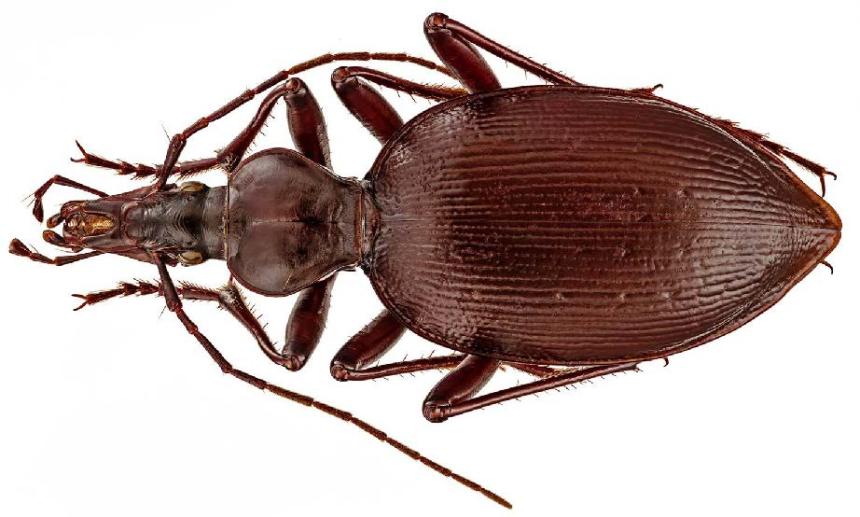Moderate-
High
In Washington, the Mann's mollusk-eating ground beetle is designated as a "Species of Greatest Conservation Need" due to small, isolated populations, limited distribution and range, and dependence on specialized, threatened habitats.
Description and Range
Physical description
The Mann’s Mollusk-eating Ground Beetle is a large, flightless ground dwelling beetle. Adult beetles are approximately 23 mm long. Adults have narrow, elongated heads and jaws, an adaptation for feeding on shell-bearing mollusks.
Ecology and life history
The Mann's mollusk-eating ground beetle is a habitat specialist that requires areas of seasonally moist soil associated for the most part with daylong shade. Beetles have commonly been found in rocky drainages, and may be found in at the margins of damp canyons that are not subject to periodic inundation of water from dams.
Both adults and larva are known to eat slugs and snails and their eggs. Development from egg, through three larval stages, to pupation and adult stage probably takes one year and only one generation of the beetle is produced per year. The adult life span is estimated to be about a year. Adults emerge from pupae in early spring, become inactive in summer, and are active again in the fall until temperatures become too cold. Adults are nocturnal, sheltering under rocks, logs, or other cover during the day. Adult beetles are flightless, so active dispersal is limited to walking, and no passive dispersal agents are known.
Geographic range
In Washington, the Mann’s mollusk-eating ground beetle is present at elevations up to 870 m in the Asotin Creek drainage, the Washington mainstem and tributaries of the Grande Ronde River, the west side of the Snake River, and the Tucannon River drainage (Asotin and Whitman counties).There is one record from northeast Oregon, and the species has recently been found in Idaho.
This beetle was originally found in damp canyons amid shaded forest or shrub patches associated with springs or small streams. However, further research shows that they are not limited to these conditions and are often found in areas a considerable distance away from creeks or riparian areas. The primary habitat requirement for this species is at least seasonally moist soil associated for the most part with daylong shade, the latter necessary for maximal soil moisture retention and heat buffering. Beetles have commonly been found in rocky drainages with rocks providing diurnal and seasonal shelter for the beetles, as well as their snail prey. The association with rocky habitat appears to be stronger than habitat with riparian vegetation.
Climate vulnerability
Sensitivity to climate change
Moderate
Limited sensitivity information is available for this species. This species seeks out shaded, moist areas and rocky habitat during the daytime. Its micro and macro habitat preferences likely make it sensitive to flooding, increasingly xeric conditions, and temperature increases.
Exposure to climate change
Moderate-
High
- Increased temperatures
- Drought
- Increased amount and/or duration of flooding
- Increased fire intensity and frequency
Conservation
Conservation Threats and Actions Needed
- Energy development and distribution
- Threat: Riparian forest areas threatened by inundation by dams.
- Action Needed: Where dams remain in rivers, develop timing and duration water level control best management practices to support species.
- Agriculture and aquaculture side effects
- Threat: Livestock use may trample the beetle or reduce riparian vegetation and compact soil. Rangeland pesticides may contaminate prey.
- Actions Needed: Install fencing to carefully manage or prohibit livestock access to occupied riparian areas. Encourage best management practices for pesticide use.
- Rural development
- Threat: Habitat is destroyed by incursion of homes, outbuildings and pasture.
- Actions Needed: Conserve and protect areas where beetles are present.
See the Climate vulnerability section for information about the threats posed by climate change to this species.
Resources
References
Greene, A. 1975. Biology of the five species of Cychrini (Coleoptera: Carabidae) in the steppe region of southeastern Washington. Melandria 19: 1-41.
LaBonte, J.R. 1995. Possible threatened or endangered terrestrial predaceous Coleoptera of the Columbia River Basin. Contract report for the USDA Forest Service (US Bureau of Land Management, Upper Columbia River Basin Ecosystem Management Project). 31 pp.
LaBonte, J.R., D.W. Scott, J.D. McIver and J. L. Hayes. 2001. Threatened, endangered, and sensitive insects in eastern Oregon and Washington forests and adjacent lands. Northwest Science (special issue) Vol. 75: 185-198.
Thiele, H.-U. 1977. Carabid beetles in their environments: a study on habitat selection by adaptations in physiology and behavior. Springer-Verlag, New York. 369 pp.
WDFW (Washington Department of Fish and Wildlife). 2018. Unpubl. data.
Wickham, H.F. 1919. Scaphinotus (Pseudonomaretus) mannii n. sp. (Coleoptera: Carabidae). Proceedings of the Entomological Society of Washington 21(7):170-173.
